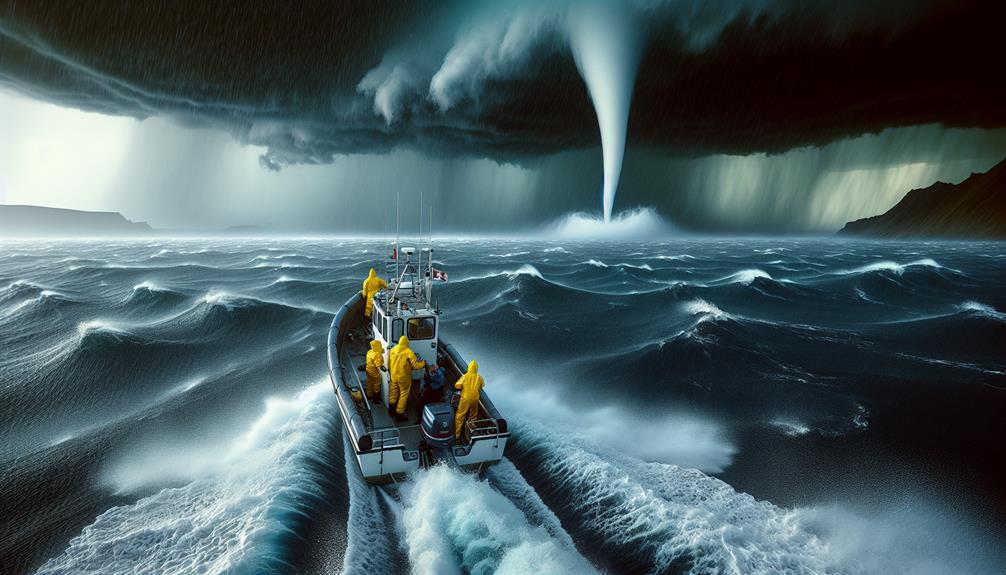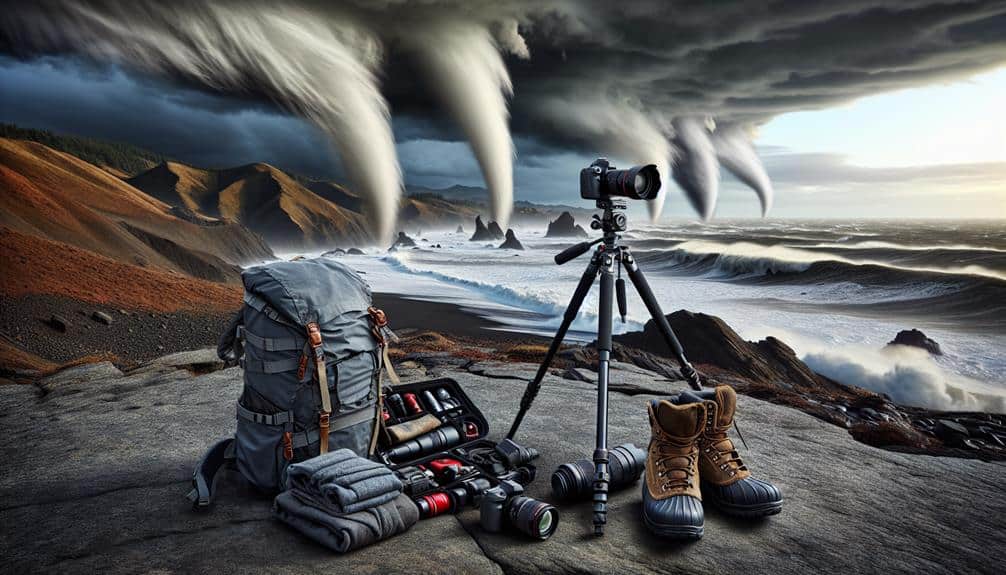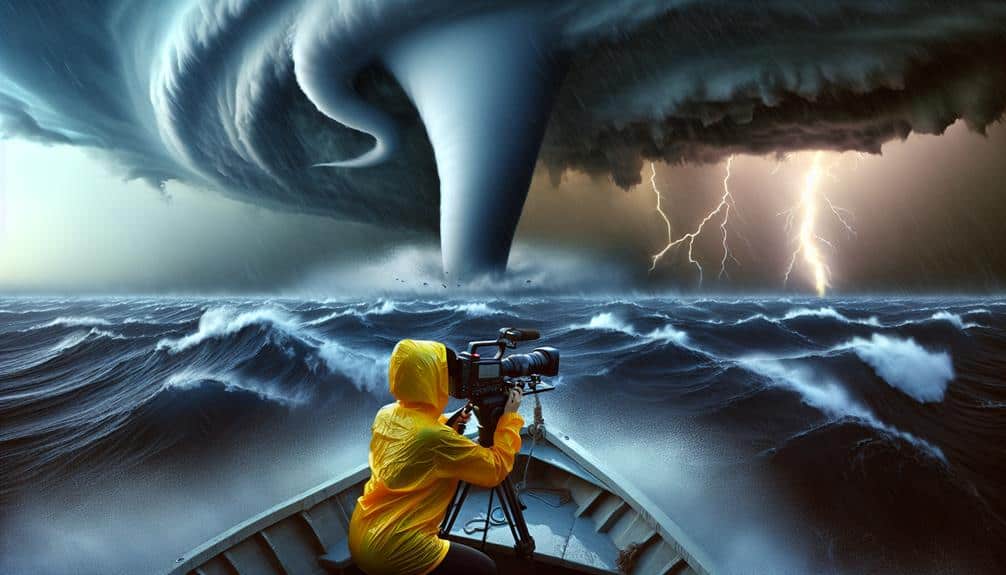Chasing waterspouts blends scientific rigor with exhilarating fieldwork as we track these marine vortices. Equipped with advanced meteorological instruments, real-time portable Doppler radars, and necessary safety gear, we navigate hotspots like the Florida Keys and the Mediterranean Sea. Understanding atmospheric conditions—such as temperature contrasts, moisture levels, and wind stability—is crucial for predicting formations. Capturing waterspouts' unique features with precise data collection enhances our predictive models and contributes to atmospheric science. Each expedition challenges us with unpredictable weather, demanding rapid adaptation and teamwork, ensuring both safety and groundbreaking discoveries in this high-stakes pursuit. Discover how we turn these encounters into scientific triumphs.
Key Points
- Waterspouts form over warm waters and exhibit lower wind speeds compared to tornadoes, creating unique chasing experiences.
- Ideal locations for observing waterspouts include the Florida Keys, Mediterranean Sea, Great Lakes, and the South China Sea.
- Advanced meteorological instruments and real-time data tools are essential for accurately predicting and safely observing waterspouts.
- Safety measures, including emergency procedures and reliable communication, are crucial in managing risks during unpredictable encounters.
Understanding Waterspouts
To understand waterspouts, we must first differentiate them from their terrestrial counterparts, tornadoes, and examine their formation processes in marine environments. Waterspouts primarily develop over warm waters, often in tropical and subtropical regions, and they exhibit unique characteristics distinct from tornadoes. Unlike tornadoes, which originate from strong, rotating updrafts within supercell thunderstorms, waterspouts form from weaker, non-supercell thunderstorms or even fair-weather cumulus clouds.
The formation process of waterspouts involves a combination of warm, moist air rising from the water's surface and converging winds at the surface. These conditions lead to the development of a rotating column of air, which intensifies as it ascends. Scientific research has shown that waterspouts typically exhibit lower wind speeds compared to tornadoes, making them less destructive but still fascinating in their dynamics.
Forecasting methods for waterspouts have evolved with advancements in meteorological technology. We use Doppler radar, satellite imagery, and computer models to predict conditions conducive to waterspout formation. Continuous scientific research aids in refining these methods, providing us with more accurate forecasts.
Essential Gear for Chasing
Effective waterspout chasing necessitates a carefully curated set of necessary gear, including advanced meteorological instruments, reliable communication devices, and appropriate safety equipment.
To accurately predict and locate waterspouts, we rely on portable Doppler radars and anemometers. These tools provide real-time data on wind speed and direction, critical for tracking storm developments. High-resolution GPS units guarantee precise navigation, enabling us to position ourselves optimally for observation and photography.
Reliable communication devices are essential. We use satellite phones and VHF radios to maintain continuous contact with our team, making sure that we can relay important information and coordinate movements. Internet-enabled devices allow us to access real-time weather updates, enhancing our situational awareness.
For capturing the awe-inspiring beauty of waterspouts, our gear recommendations include DSLR cameras with weather-sealed lenses. Utilizing a tripod stabilizes the shot in windy conditions, while wide-angle lenses capture the full scale of the storm. Rapid shutter speeds and high ISO settings are necessary photography tips for storm chasing, enabling us to freeze the motion of turbulent water and clouds.
In essence, having the right gear not only amplifies the thrill of storm chasing but also ensures a safe and productive expedition.
Safety Precautions
While advanced gear is necessary for tracking and documenting waterspouts, adhering to strict safety precautions is vital to mitigate risks during our expeditions. We must prioritize emergency procedures and effective risk management to guarantee our safety in unpredictable environments.
Here are key measures we should take:
- Emergency Procedures: Establish and rehearse emergency procedures that cover a range of scenarios, including sudden changes in weather conditions and equipment failures. These procedures should be detailed and readily accessible.
- First Aid: Equip ourselves with thorough first aid kits designed for marine and coastal environments. Ensure that at least one team member is certified in advanced first aid and CPR, capable of addressing potential injuries.
- Communication Strategies: Utilize reliable communication strategies, such as satellite phones and VHF radios, to maintain constant contact with both team members and external emergency services. This ensures we can relay our position and status swiftly.
- Risk Management: Conduct detailed risk assessments before each expedition. This includes analyzing weather forecasts, understanding local maritime regulations, and identifying potential hazards. Implement a dynamic risk management plan that adapts to real-time conditions.
Ideal Locations Worldwide
We've identified several key global hotspots where conditions are ideal for observing and studying waterspouts, based on historical data and meteorological patterns.
The Florida Keys stand out as one of the top destinations, particularly from June to September, when sea surface temperatures and atmospheric conditions are most favorable. During these months, the convergence of warm waters and atmospheric instability frequently leads to waterspout formation.
In the Mediterranean Sea, the coastlines of Italy and Greece are prime locations, especially from late summer to early autumn. Here, the combination of warm sea temperatures and seasonal weather changes creates an excellent environment for waterspouts.
Additionally, the Great Lakes in North America, particularly Lakes Erie and Ontario, offer excellent opportunities during late summer and early fall. The interaction between the relatively warm lake waters and cooler air masses can trigger waterspout activity.
Lastly, the South China Sea, near the coasts of Malaysia and the Philippines, provides another hotspot. The best times to observe waterspouts in this region are typically during the monsoon season, when the dynamic weather conditions heighten the likelihood of waterspout occurrences.
Weather Patterns to Watch

Understanding the specific weather patterns conducive to waterspout formation is essential for accurate predictions and successful observations. We need to explore the complexities of storm tracking and meteorological phenomena to identify the ideal conditions.
Waterspouts typically form under specific atmospheric conditions, most commonly in the presence of towering cumulus or cumulonimbus cloud formations. These clouds indicate the necessary instability in the atmosphere.
Here are four key weather patterns to watch:
- Temperature Contrasts: Sharp temperature differences between water surfaces and the air above can create the instability required for waterspouts.
- Converging Air Currents: When wind patterns converge at the surface, they can initiate the rotation needed for waterspout formation.
- High Moisture Levels: Elevated moisture content in the lower atmosphere fuels the development of strong updrafts, crucial for waterspout genesis.
- Stable Wind Conditions: Minimal changes in wind speed and direction with height allow the vertical structure of waterspouts to remain intact.
Capturing Stunning Footage
How can we make sure that our equipment and techniques are optimized for capturing the most stunning and scientifically valuable footage of waterspouts?
First, we need to guarantee our cameras, drones, and GoPros are equipped with high-resolution capabilities and stabilization features. High frame rates, such as 60fps or higher, allow us to capture intricate vortex movements. Utilizing drone perspectives grants us unparalleled aerial views, enabling us to document the full structure and dynamics of the waterspout.
We should employ advanced filming techniques, including time-lapse and slow-motion, to highlight the formation and dissipation stages. GoPro angles can be strategically placed on boats or static mounts to capture close-up, immersive shots. Editing tricks like color correction and contrast adjustments will enhance visibility, making the footage both visually stunning and scientifically insightful.
Data collection is equally important. Embedding metadata, such as GPS coordinates and timestamping, ensures that each frame can be analyzed in context. By integrating these technical strategies, we don't just capture the beauty of waterspouts, but also gather valuable data for meteorological research. This approach empowers us to explore freely while contributing to the scientific community.
Stories From the Field

In the field, our team has encountered a myriad of challenges and breakthroughs while documenting waterspouts. Our thrilling encounters have been marked by an adrenaline rush, technical precision, and data collection. Each field expedition presents unique obstacles that test our skills and resolve.
For instance, one of our most memorable experiences involved a sudden shift in weather patterns, leading to an unexpected waterspout formation. This required rapid adaptation and quick decision-making.
To optimize our safety and the integrity of our data, we adhere to the following protocols:
- Weather Monitoring: We utilize advanced meteorological tools to track real-time changes.
- Equipment Preparedness: Our gear, from high-resolution cameras to barometers, is always in top-notch condition.
- Team Coordination: Constant communication through radios and GPS ensures efficient maneuvering.
- Data Logging: Meticulous recording of atmospheric variables aids in post-analysis.
These experiences don't just offer an adrenaline rush; they contribute to our understanding of atmospheric phenomena. Our data-driven approach helps us refine predictive models and enhances our ability to anticipate future waterspout occurrences.
The freedom to explore and document these natural marvels fuels our passion and commitment to this scientific pursuit.
Frequently Asked Questions
How Do Waterspouts Impact Marine Life?
Waterspouts act as nature's upheaval, symbolizing disruption in marine habitats. They can greatly alter ecosystem health by displacing species, affecting food chains, and introducing pollutants into delicate ocean environments, impacting overall marine biodiversity and stability.
Are There Any Myths or Legends Surrounding Waterspouts?
Yes, there are myths and legends surrounding waterspouts. Folklore tales and superstitions often attribute supernatural beliefs to them, reflecting their cultural significance. Various cultures view waterspouts as omens or manifestations of otherworldly powers.
What Are the Economic Impacts of Waterspouts on Coastal Communities?
Waterspouts, while visually mesmerizing, can subtly shift our coastal economies. They impact tourism revenue, cause infrastructure damage, disrupt the fishing industry, and accelerate beach erosion. These changes demand adaptive strategies to preserve both livelihoods and freedoms.
Can Waterspouts Occur in Freshwater Bodies?
Yes, freshwater spout sightings do occur in lakes and rivers. This weather phenomenon forms under specific conditions, including temperature gradients and wind shear. These spouts are less common than their oceanic counterparts but still fascinating to observe.
How Do Different Cultures Interpret Waterspouts?
Let's hop in our DeLorean and explore how different cultures interpret waterspouts. Many view them through cultural interpretations and folklore legends, with scientific accuracy indicating they symbolize omens, divine messages, or natural phenomena, depending on the region.


